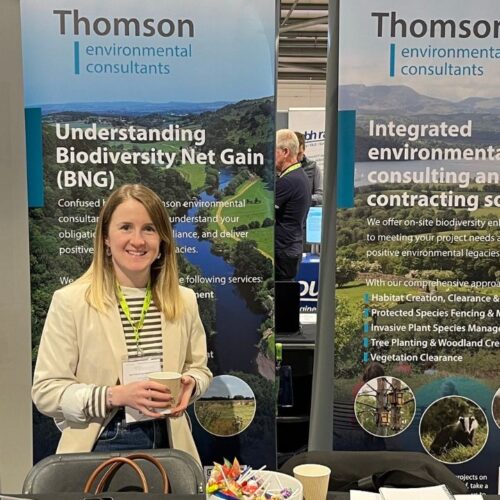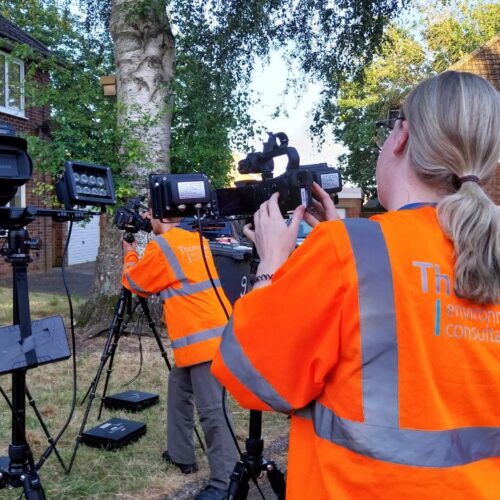The role of a Site Supervisor in an environmental consultancy is multifaceted. It requires a balance between technical expertise, team management, and client relations and has critical responsibilities and challenges.
We spoke to Jay Dowling, one of our Site Supervisors, to get an understanding of his day-to-day role, the challenges they face, and safety considerations on development projects at Thomson Environmental Consultants.
Keep reading to find out more about Jay’s role!
Day in the life as a Site Supervisor
As a supervisor working on ecological mitigation sites, the day starts early. It is filled with various responsibilities, each crucial to the project’s success and the team’s safety. Here’s what Jay told us about what a typical day for him might involve:
1. The day begins with outlining roles and assigning PPE
Daily briefs are essential for ensuring that everyone understands their roles and responsibilities. I distribute and review all necessary paperwork, ensuring each team member has signed off on safety protocols, job assignments, and any updates on the project.
2. Risk Assessment and Method Statement and PPE
Ensuring that the site and team adhere to the health, safety, quality, and environmental (HSQE) standards is paramount. It’s vital that everyone receives and understands a detailed brief of the RAMS (Risk Assessment and Method Statement). It’s also essential to reiterate safety protocols and the importance of PPE (Personal Protective Equipment) specific to the site and each individual’s roles daily.
3. Site inspection
When arriving on site, I ask the team to wait until I have conducted a thorough inspection, identifying any hazards in the work area that have not been recorded in the RAMS or were not previously there, such as other works, plant people interface, or changes to the ground conditions.
I will carry out a point-of-work risk assessment on each site and deliver a brief before commencing work; this is extremely important. All the team members must be aware of any control measures in place to prevent injury or near misses. Throughout the day I continue to undertake regular site inspections, looking for any new risks, ensuring compliance with safety standards.
4. Coordinate with other team members on site
Throughout the day, I coordinate with various team members, including ecologists and site operatives, to ensure everyone is aligned and that any issues are addressed swiftly. Effective communication is vital, especially when working with a multidisciplinary team on complex projects.
5. Debriefing session at the end of the day
At the end of the day, I gather the team for a debriefing session. We review the day’s accomplishments, discuss any issues encountered, and plan for the next day. This session also includes a review of safety practices and any incidents that may have occurred.
All related documentation is updated, and any necessary reports are submitted. I will also send the project manager and client a document containing annotated before-and-after photographs of each task carried out.
Challenges and considerations of ecological mitigation
Jay also delved into the potential challenges of his Site Supervisor role in an environmental consultancy and how he works with the team to overcome them:
Respecting fragile habitats
Working on ecological mitigation sites involves respecting and preserving the natural habitat. This means careful planning to avoid disrupting wildlife. I will ensure that the ecologist has inspected the work area and delivered a thorough brief to the team outlining specific ecological constraints, such as nesting seasons or the presence of endangered species that may be on site.
To prevent any habitat-related challenges or mistakes, we follow strict guidelines to ensure our activities do not harm the environment or wildlife.
Strict deadlines
Another critical challenge is adhering to strict deadlines. Environmental consultancy projects often have tight schedules due to ecological constraints, seasonal deadlines, and the need to minimise disruptions to wildlife.
To overcome deadline challenges on ecological mitigation projects, I prioritise tasks, allocate resources efficiently, and monitor daily progress to ensure we stay on track. A significant part of this process requires frequent, daily collaboration with the project manager to discuss the status of the works and highlight any delays, allowing us both to develop solutions and strategies to improve our performance.
In addition, transparency and regular updates help project management and the operations manager align resources efficiently, preemptively plan, mitigate risks, and ensure the work is on schedule and within budget.
Weather constraints
Finally, weather is a significant challenge when working outdoors and can sometimes prevent ecological mitigation objectives from being achievable. Adverse conditions, such as rain or extreme temperatures, can affect safety and efficiency while significantly hindering the quality and effectiveness of the work.
To mitigate weather challenges, I monitor daily forecasts closely and adjust plans accordingly. If severe weather is expected, I prepare the team for potential delays, liaise with the client, and ensure we have contingency plans in place.
What skills do you need to become a Site Supervisor?
Being a supervisor involves managing projects, leading multidisciplinary teams, and ensuring compliance with environmental regulations while maintaining strong client relationships and fostering sustainable practices.
Here are the four core Skills that Jay demonstrates in his day-to-day role:
Technical expertise
Supervisors must possess a high level of technical expertise to guide their teams effectively. Effective team management and leadership are crucial for the success of habitat management and creation projects and for maintaining strong client relationships.
Liaising with administration
A Site Supervisor must also be able to coordinate with the admin team to keep the paperwork up to date and help them organise adequate welfare facilities for the team. Liaising with the administration team to corroborate that required equipment and materials are delivered on time will prevent work stoppages and keep the project driving forward.
Time management
Effectively managing your team requires learning each individual’s strengths and weaknesses. Assigning someone to a proficient role is beneficial to productivity, but it’s also crucial to allow them to learn a new skill. This will help their personal development, allowing them and the business to grow professionally.
Communication with senior site employees
Overall, it’s vital for me to communicate regularly with the Senior Site Supervisor. This relationship is crucial for maintaining high standards of site work. I will receive regular audits, which are thorough examinations of our compliance with HSQE standards.
Safety considerations as a Site Supervisor
With any ecological project on an ongoing development site, such as habitat management, species surveys or data capture projects, there are unique safety risks for the whole team, and Jay uses the following strategies to support the project:
To keep safety at the forefront, I hold toolbox talks. These are short, focused discussions about specific safety topics approved by the Senior Site Supervisor. These talks are conducted at regular intervals or when new hazards are identified. They serve as reminders and allow a safe space for the team to raise concerns.
In the event of an incident, I am responsible for reporting and documenting it promptly. This involves ensuring the affected individual receives appropriate care by completing detailed reports outlining what happened, why, and how similar incidents can be prevented. This information is crucial for continuous improvement of our safety protocols.
Being a supervisor in an environmental consultancy is a demanding yet rewarding role. It requires balancing multiple responsibilities, managing strict deadlines, and quickly resolving unexpected obstacles while ensuring ecological preservation and safety. Each day presents new challenges, but with careful planning, effective communication, and a commitment to safety, the team can achieve its goals while protecting the natural environment.
The benefits of a Site Supervisor for your development project
Commissioning a Site Supervisor significantly benefits a development project, especially a large site with many moving parts. Site Supervisors play a crucial role in organising the team and resources to help the development project run smoothly, mitigating delays and quickly resolving time management issues.
We can provide you with an experienced Site Supervisor familiar with specific project requirements, including highway infrastructure, commercial and residential development and renewable energy.
Get in touch to discuss your requirements, and a member of our friendly team will guide you through how we can help manage your upcoming project smoothly.











